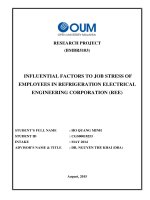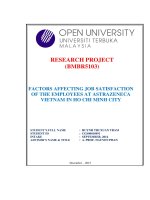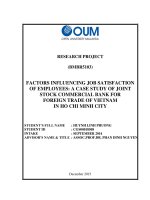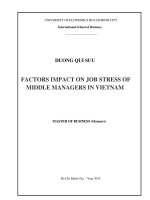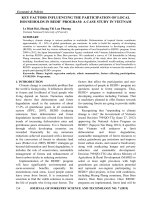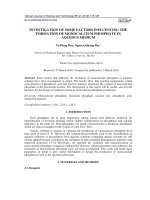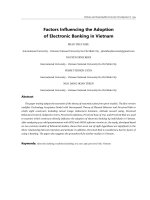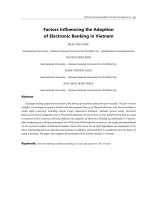Factors influencing job stress of agribank employees in da lat
Bạn đang xem bản rút gọn của tài liệu. Xem và tải ngay bản đầy đủ của tài liệu tại đây (1.57 MB, 63 trang )
RESEARCH PROJECT
(BMBR5103)
FACTORS INFLUENCING JOB STRESS OF
AGRIBANK EMPLOYEES IN DA LAT
STUDENT’S FULL NAME
: LUONG HUYNH NGOC TIEN
STUDENT ID
: CGS00018524
INTAKE
: SEPTEMBER 2014
ADVISOR’S NAME & TITLE
: DR. NGUYEN THE KHAI (DBA)
December, 2015
ADVISOR’S ASSESSMENT
............................................................................................................................................
............................................................................................................................................
............................................................................................................................................
............................................................................................................................................
............................................................................................................................................
............................................................................................................................................
............................................................................................................................................
............................................................................................................................................
............................................................................................................................................
............................................................................................................................................
............................................................................................................................................
............................................................................................................................................
............................................................................................................................................
............................................................................................................................................
............................................................................................................................................
............................................................................................................................................
............................................................................................................................................
............................................................................................................................................
Advisor’s signature
Nguyen The Khai, DBA
RESEARCH PROJECT
Contents
List of tables …………………………………………………………………………...4
List of figures …………………………………………………………………………..5
Abbreviations …………………………………………………………………………..6
Acknowledgement ……………………………………………………………..............7
Abstract ………………………………………………………………………………...8
CHAPTER I: INTRODUCTION …………………………………………………….9
I. INTRODUCTION OF AGRIBANK ………………………………………………9
1. Overview of the company …………………………………………………..……...9
2. Agribank's milestones in development ……………………………………..……11
3. Sustainable development and growth ………………………………………..…..12
4. Agribank network …………………………………………………………………14
5. Agribank's core cultural values ……………………………………………..........14
6. Agribank’s subsidiaries …………………………………………………………...16
7. Organization Structure ……………………………………………………………17
8. Agribank network …………………………………………………………………17
9. Business Objectives ………………………………………………………………..18
II. RESEARCH INTRODUCTION …………………………………………...……19
1. Problem statement…………………………………………………………………19
2. Research objective…………………………………………………………………19
3. Research questions…………………………………………………………...……19
4. Demographic Characteristics of the respondents……………………………….19
CHARPTER II: LITERATURE REVIEW …………………………………….....22
I. STRESS IN THE WORKPLACE………………………………………………..22
II. DEFINING JOB STRESS…………………………………………………….....22
III. CAUSES OF JOB STRESS…………………………………………………….22
1. Work-life balance …………………………………………………………….….23
2. Work Control………………………………………………………………….…23
LUONG HUYNH NGOC TIEN
2
RESEARCH PROJECT
3. Job Overload……………………………………………………………………...23
IV. SOURCES OF JOB STRESS ……………………………………………….…24
CHARPTER III: RESEARCH MODEL AND HYPOTHESES ……………...…25
I. RESEARCH MODEL……………………………………………………............25
1. Dependent Variables…………………………………………………………..…25
2. Independent Variables………………………………………………………..….25
II. CONSTRUCTS ……………………………………………………………….…26
III. RESEARCH HYPOTHESES …………………………………………………26
CHARPTER IV: RESEARCH METHODS AND DATA ANALYSIS………….29
I. RESEARCH DESIGN…………………………………………………………....29
II. RESEARCH METHODS…………………………………………………….....29
1. Data collection method…………………………………………………………..29
2. Measures……………………………………………………………………..…...29
2.1. Work-Family Conflict ……………………………………………………..….30
2.2. Work Tension ………………………………………………………………....31
2.3. Work Control ………………………………………………………………....32
2.4. Job Overload ……………………………………………………………..…...35
2.5. Job Stress …………………………………………………………………...…36
3. Research Participants ………………………………………………………….37
4. Data analysis and report …………………………………………………….…38
4.1.Reliability Analysis …………………………………………………………....39
4.2.Descriptive Analysis …………………………………………………………..40
4.3.Correlation among available ………………………………………………....41
4.4.Hypothesis Testing ………………………………………………………..…..42
CHARPTER V: DISCUSSION AND CONCLUSIONS …………………..…...44
SUMARY OF RESULT…………………………………………………………..44
DISCUSSION AND RECOMMENTDATION……………………………..…..44
III.LIMITATION OF THE STUDY ……………………………………………47
LUONG HUYNH NGOC TIEN
3
RESEARCH PROJECT
IV.CONCLUSIONS ………………………………………………………..….48
REFERENCES ………………………………………………………………...49
APPENDIX 1- QUESTIONNAIRE …………………………………………..52
APPENDIX 2 - PRESENTATION POWERPOINT ……………………….56
LUONG HUYNH NGOC TIEN
4
RESEARCH PROJECT
LIST OF TABLE
Table 1: Reliability Statistic of Cronbach’s Alpha………………………………………..40
Table 2: Descriptive Statistics…………………………………………………………….40
Table 3: The Pearson’s Correlation……………………………………………………….41
Table 4: Model Summary…………………………………………………………………42
Table 5: Coefficients……………………………………………………………………...43
LUONG HUYNH NGOC TIEN
5
RESEARCH PROJECT
LIST OF FIGURES
Figure 1: Mr. Trinh Ngoc Khanh, chairman of Agribank…………………………..10
Figure 1: Mr. Trinh Ngoc Khanh, chairman of Agribank.………………………….18
Figure 3: A summary of demographic characteristics of the respondents ………..22
Figure 4: Suggested Research Model of Agribank Employees’ Job Stress ……...26
LUONG HUYNH NGOC TIEN
6
RESEARCH PROJECT
ABBREVIATIONS
APRACA
Asia Pacific Rural and Agricultural Credit Association
VBA
Vietnam Bank for Agriculture
WB
World Bank
ADB
Asia Development Bank
AFD
French Development Agency
EIB
European Investment Bank
ABC
Agricultural Bank of China
CCB
China Construction Bank
ICBC
Industrial and Commercial Bank of China
ALC 1
Financial Leasing Company No. 1
AJC
Viet Nam Agribank Gold Corporation. Jsc.
ALC 2
Financial Leasing Company No. 2
Agriseco
Securities Joint stock Company
VJC
Silver and Gemstone Company
ABIC
Agribank Insurance Joint stock Corporation
LUONG HUYNH NGOC TIEN
7
RESEARCH PROJECT
ACKNOWLEDGEMENT
Dear Dr. Khai Nguyen and all my beloved
I would like to express my most grateful and sincere thanks to my lecturer, Dr. Khai
Nguyen. I am so appreciative for numerous hours that Dr. Khai Nguyen dedicated
to me and my study. He was always available to offer his encouragement and added
inspiration to my research and strengthened my passion for the field of business
research and through his lessons.
This research won’t be completed without the help of my beloved classmates. I was
very fortunate to have such terrific mates who gave me useful and constructive
advices, great help as well as encouragement.
I also send my sincere thanks to many other friends and my family who supported
and helped me a lot in collecting survey and during my study.
My best regards
Ngoc Tien
LUONG HUYNH NGOC TIEN
8
RESEARCH PROJECT
ABSTRACT
Stress is a universal element and everybody has to face with stress not only in every
walk of life but also in their job. Work stress is nowadays becoming a serious
problem in the workplace. Employees in general and bank officers in specific often
get troubles, crises and conflicts in their current working environment that requires
them to handle fast, flexibly and accurately. This research is aimed at catching out
factors affecting Job stress to employees who work in Agribank. Data was collected
with the help of questionnaire and correlation and regression were used to analyze
the data. Finding showed different factors that influenced on job stress of employees
and also ways to reduce their job stress. This paper was conducted to analyze the
relationship between job overload and job stress; role overload and job stress;
perceived injustice and job stress; work-family conflict and job stress. The study
was done on 296 employees working in Agribank branches around Da Lat city to
assess the elements affecting the Job stress in the organization. As a result,
organizations can reduce the overall impact of work stress by developing and
implementing preventive measures and interventions to help employees manage and
cope with job stress.
Key words: job stress, work-family conflict, work tension, work control, job
overload.
LUONG HUYNH NGOC TIEN
9
RESEARCH PROJECT
CHAPTER I: INTRODUCTION
I would like to introduce a research about “Factors Influencing Job Stress of Agribank
Employees in Da Lat”.
I. INTRODUCTION OF AGRIBANK
1. Overview of the company
Agribank - the leading commercial bank in Vietnam
Since its establishment in 1988, Vietnam’s Agribank has continuously played
a key role in contributing to the development and significant achievements of
the country’s valuable agricultural industry.
Figure 1: Mr. Trinh Ngoc Khanh, chairman of Agribank
(Source: Agribank website)
Agribank is the largest bank in Viet Nam in terms of capital, assets, workforce,
operating network and customer base. As of October 2012, the leading role of
Agribank has been confirmed by:
Total asset: VND 560,000 billion
Total fund resource: VND 513,000 billion
Equity: VND 29,605 billion
Total outstanding loans: VND 469,000 billion
LUONG HUYNH NGOC TIEN
10
RESEARCH PROJECT
Operating network: 2,400 branches and transaction offices nationwide
Personnel: 42,000 staffs
Agribank has always focused on the innovation and application of banking
technology in favor of business administration and the development of an advanced
banking services network. Agribank is the first bank to accomplish the Project
"Intra Payment and Customer Accounting System" (IPCAS) funded by the World
Bank. The finalized IPCAS has enabled Agribank to provide local and foreign
customers with modern banking products and services with extensive safety and
accuracy. At present, Agribank is serving millions of households and enterprises.
Agribank is one of the banks in Viet Nam who have the largest number of
correspondent banks with 1,033 correspondent banks in 92 countries and territories.
Agribank is currently taking the Chairmanship of Asia Pacific Rural and
Agricultural Credit Association (APRACA) in term of 2008-2010, and also a
member of International Agricultural Credit Confederation (CICA) and Asian
Bankers Association (ABA). Agribank has hosted a number of big international
conferences, i.e., FAO Conference in 1991, APRACA Meeting in 1996 and 2004,
CICA International conference on agricultural credit in 2001, APRACA Meeting on
fishery in 2002.
Agribank is the leading bank in Viet Nam in receipt and implementation of foreign
projects. In the context of economic volatility, Agribank has received 136 projects
from the World Bank (WB), Asian Development Bank (ADB), French
Development Agency (AFD), European Investment Bank (EIB), etc. with the total
fund of over USD 5.1 billion. Apart from this, Agribank has continuously got
accessed to and attracted new projects: Financing Agreement with European
Investment Bank (EIB) phase II; Rural Finance Project III funded by World Bank,
Biogas Project funded by ADB; JBIC Project by Japan; Small rubber farming
project funded by AFD. With the position of a leading commercial bank in Viet
Nam, Agribank has shown its great efforts, reaching encouraging achievements, and
LUONG HUYNH NGOC TIEN
11
RESEARCH PROJECT
contributing greatly to the nation's industrialization and modernization as well as
economic development.
2. Agribank's milestones in development:
1988: Establish on 26 March 1988 under the name of Agricultural
Development Bank of Vietnam.
1990: Renamed Vietnam Bank for Agriculture (VBA).
1991: Implemented loans for the household economic sector under Directive
202/CT dated 28 June 1991 by the Chairman of the Council of
Ministers.
1995: Proposed establishment of the Bank for the Poor (now called the
Vietnam Bank for Social Policies) – A separate entity from the
Vietnam Bank of Agriculture.
1996: Renamed Vietnam Bank for Agriculture and Rural Development
2003: Awarded the title of “Labor Hero of the Doi Moi Era” by the Party
and State.
-
Deployed Intrabank Payment and Customer Accounting System
(IPCAS) at Agribank branches nationwide.
2005: Open first representative office abroad - Representitive Office in
Cambodia.
2006: Obtained Vietnam Gold Star Award.
2007: Ranked by UNDP as the largest emterprise in Vietnam.
2008: Awarded the “Second-Class Independence Medal” by the party and
the State.
-
Took up Chairmanship of the Asia – Pacific Rural and Agricultural
Credit Association (APRACA) Top 10 Vietnam Gold Star Award.
2009: Recognized as the first bank to be awarded the “Top 10 Vietnam Gold
Star” Award twice.
Officially kicked off the IPCAS II, connecting online all 2,300
branches and transaction offices.
LUONG HUYNH NGOC TIEN
12
RESEARCH PROJECT
2010: named in top 10 of 500 largest enterprises in Vietnam – VNR500.
Opened first branch abroad – Branch in Cambodia.
2011: Converted into a State – Owned one member limited liability
company.
2012: the only bank in the top 10 ranking of 500 largest enterprises in
Vietnam – VNR500.
2013: 25th anniversary of the establishment, honorably received the ThirdClass Labor Medal from the Government.
2014: Implemented Restructuring Plan with the aim of continuing to play a
key role in the system of credit institutions in Vietnam, directly
responsible for implementing the policy of the Party and State on
development assistance and the provision of financial services for
agriculture, rural areas and farmers. The only bank in the top 10
ranking of 500 largest enterprises in Vietnam – VNR500.
3. Sustainable development and growth:
Agribank is the biggest bank in Viet Nam in terms of fund resources, assets,
number of staff, operating network and customer base. As of December 2013,
Agribank had the total assets of VND 705,365 billion, total equity of VND 29,605
billion, total fund resource of VND 626,390 billion, total outstanding loans of VND
530,600 billion, total staff of 40,000 people; 2,300 branches and transaction offices;
1,000 correspondent banks in 100 countries and territories and a customer base of
over millions customers...Agribank is a leading bank in Viet Nam in terms of
receipt and implementation of foreign projects, especially from the World Bank
(WB), Asia Development Bank (ADB), French Development Agency (AFD), and
European Investment Bank (EIB). Agribank is currently taking the chairmanship of
Asia Pacific Rural and Agricultural Credit Association (APRACA) in term of 2008
- 2010. Recently, Agribank has been known as a leading bank which provides
modern services.
LUONG HUYNH NGOC TIEN
13
RESEARCH PROJECT
For the coming years, Agribank is to promote the role of the leading bank in the
national economic development and the dominant role in agricultural and rural
financial market, serving agriculture, farmers and rural areas. Agribank will make
great efforts in fund mobilisation from both local and foreign sources, maintain the
credit growth at a reasonable level. Agribank will give priority in investment in
agriculture, farmers and rural areas especially to farm households with agricultural,
forestry, fishery, and salt production and to SMEs which has met the demand for
transition to agricultural and rural production. As a result 70% of the total
outstanding loans will be in agriculture and rural areas. For maintaining the leading
bank providing the modern and high quality products and services, meeting the
demand of customers and increasing the noncredit income, Agribank is focusing on
renovate and develop banking technology in a modernisation manner. Agribank
expects to reach the goals for 2014 as follows: the fund resource increases by 11%13%, outstanding loand rised by 10%-12%; the rate of loans to agricultural and
rural areas is 70%, NPLs below 4%, to meet the safe rates required by SBV.
To reach those ends, Agribank will put forth a number of solutions such as:
Speeding up the fund mobilisation from different sources for serving agriculture,
farmers and rural areas; Enhancing the cooperation and connection with big
organisations and enterprises; Set up the progress on implementing the Agribank
re-structure project; Effectively management ; Develop strategy on international
cooperation and foreign funded projects. Agribank has completely changed into Ltd
Company with 100% capital of State; Pushing up the modernised banking
technology to develop the new products and services with high quality to better
serve the customers in agriculture, farmer and rural areas, enhance competitive
advantage and increase noncredit income; Set up the strategy on high quality human
resource; Agribank plans to carry out the project on bussiness development strategy
in coming years; develop the promotion strategy for Agribank trade mark
etc…continuously affirmed the status and prestige of the largest commercial bankfinancial institution in Vietnam.
LUONG HUYNH NGOC TIEN
14
RESEARCH PROJECT
4. Agribank network:
2,300 branches and transaction offices across the S shape of Vietnam
Agribank is the biggest commercial bank in Vietnam with an operating network of
2,300 branches and transaction offices nationwide which have been connected
online. In 2010, Agribank has extended the network by opening its first branch in
the Kingdom of Cambodia.
With the leading role in rural and agricultural financial market, Agribank has paid
attention to expand its operating network to districts and communes in order to
facilitate the customers around the country to get access to bank loans easily and
safely. The customer base of Agribank now includes over 10 million farm
households and 30,000 enterprises. The nationwide network has created Agribank
advantage in improving the competitiveness in the challenging integration process.
To meet the demand for import-export payment of local and foreign customers,
Agribank has focused on expanding the correspodent relations with other banks. So
far, Agribank has 1,034 correspondent banks in 95 countries and territories.
Agribank signed agreements with Phongsavanh Bank - Laos, Acleda Bank Cambodia, Agricultural Bank of China (ABC), Bank of China (BOC), China
Construction Bank (CCB), Industrial and Commercial Bank of China (ICBC) on
cross border payment from which customers and all parties benefit.
Apart from 2,300 branches and transaction offices, as a leading commercial bank in
Viet Nam, Agribank has 9 subsidiaries: Financial Leasing Company No. 1 (ALC 1),
Financial Leasing Company No. 2 (ALC 2), Viet Nam Agribank Gold Corporation
Jsc. (AJC), Printing, Trading and Banking Service Company, Securities Joint stock
Company (Agriseco), Tourism and Trading Company (Agribank Tours), Ho Chi
Minh City Gold, Silver and Gemstone Company (VJC), Agribank Insurance Joint
stock Corporation (ABIC), Agribank Food Trading & Development Investment
Company.
5. Agribank's core cultural values:
LUONG HUYNH NGOC TIEN
15
RESEARCH PROJECT
Agribank's core cultural values are Honesty, Discipline, Creativity, Quality, and
Efficiency.
5.1. Honesty: is interpreted as per someone's thought, something has existed
and happened or integrity, truthfulness (an honest person or a person with
honesty).
5.2. Discipline: is interpreted as "code of ethics that governs the society, the
organization, family to consolidate the relationship within a lifestyle that
complies with the moral rules. Customs and regulations form the social
order. Discipline must be followed"
5.3. Creativity: is interpreted as "Creating something new or study for
improvement without compulsion.
5.4. Quality: is interpreted as value of benefits (towards quantity)
Product quality (in economic terms): Product characteristics defined by
parameters which are measurable and comparable, in line with current
technical conditions to meet the social and personal demand in an identified
production
and
consumption
condition.
Product
quality
reflects
comprehensively the level of technology and is an important technical and
economic standard to improve production efficiency and play an essential
role in economics (expand production scale and market especially
international market)
Job quality means the guarantee of the production, technical and
organization process, resulting in qualified products and product quality
improvement. Job quality also includes the quality of the business decision
and onsite compliance which is measured by job productivity, job efficiency,
product quality and economic efficiency of various divisions and positions.
Job quality plays a decisive role to product quality and a guarantee to product
quality. The former and the latter are different but have close relations.
Efficiency is construed as "an achievement in a job or in an activity"
LUONG HUYNH NGOC TIEN
16
RESEARCH PROJECT
5.5. Efficiency: means the expected outcome or something that produces the
result that people expect and aim at, and may vary through different fields
(economic
efficiency,
socio-economic
efficiency,
labour
efficiency,
efficiency and efficiency rate).
In production, efficiency means performance and productivity. In business,
efficiency means interest rate and profits. In work performance, efficiency
means labor productivity assessed by a period of time to produce a product
or number of products produced within a period of time.
6. Agribank’s subsidiaries:
The bank’s subsidiaries include:
Agribank Securities Company ( Agriseco)
Agriculture Bank Insurance Joint Stock Corporation (ABIC)
Agribank Gold Joint Stock Corporation (AJC)
Agribank Gold, Silver and Gemstone Company, Ho Chi Minh City (VJC)
Agribank Printing, Trade and Service Company
Agribank Trading an TourismCompany (Agribank Tours)
Agribank Leasing Company No.1 (ALC1)
Agribank Leasing Company No.1 (ALC1)
LUONG HUYNH NGOC TIEN
17
RESEARCH PROJECT
7. Organization Structure
Figure 2: Agribank management organization
8. Agribank network:
2,300 branches and transaction offices across the S shape of Vietnam
Agribank is the biggest commercial bank in VietNam with an operating
network of 2,300 branches and transaction offices nationwide which have
been connected online. In 2010, Agribank has extended the network by
opening its first branch in the Kingdom of Cambodia.
The customer base of Agribank now includes over 10 million farm
households and 30,000 enterprises. The nationwide network has created
LUONG HUYNH NGOC TIEN
18
RESEARCH PROJECT
Agribank advantage in improving the competitiveness in the challenging
integration process.
Agribank has 1,034 correspondent banks in 95 countries and territories.
Agribank signed agreements with Phongsavanh Bank - Laos, Acleda Bank Cambodia, Agricultural Bank of China (ABC), Bank of China (BOC), China
Construction Bank (CCB), Industrial and Commercial Bank of China (ICBC)
on cross border payment from which customers and all parties benefit.
9. Business Objectives
9.1. Vision
AGRIBANK aims to become Vietnam’s leading Rural Bank in areas with
budding tourism and progressing farming industry; a household name for
the Vietnamese family as a reliable source of quality financing services.
9.2. Mission
To promote agriculture and its related activities through affordable and
sustainable financial solutions towards socio-economic development in
Vietnam.
9.3. Agribank commitments to employees and human resource manager
Agribank focuses on developing and holding people across all the businesses
they run.
Developing People
Agribank knows that the greatest asset of any business are people and training and
development programs can help the business have further growth of their capability
and contribution. As a result, regular development workshops were carried out for
mid-level managers in various parts such as finance, operation and marketing in
order to introduce a thorough knowledge base for a basic understanding of each
aspect for each Group in the business.
LUONG HUYNH NGOC TIEN
19
RESEARCH PROJECT
II. RESEARCH INTRODUCTION
1. Problem statement
Most of organizations, especially successful ones nowadays focus not only on
monitoring workplace stress but also implementing vehicles to reduce stress for all
employees. According to the company management, good working environment,
good treatment from the company, a stable income can make the staff feel
comfortable and contribute their best to the company. In reality, those individuals
who usually get stress due to family conflict, work tension, work control, job
overload, role overload, etc. can be affected negatively the work efficiency and the
stages involved in the process. In order to create high performance organizations,
Agribank needs to understand how stress affects people’s emotional, intellectual,
and interpersonal functions and reduce these effects effectively.
Concerning this issue, the study was conducted to survey the factors influencing Job
stress of Angribank employees in Dalat.
2. Research objective
This study mainly tries to find the following objectives:
a. To find out the factors that may impacts on Job stress.
b. To identify the factors that may impact on Job Stress.
c. To suggest some solutions based on research findings in order to reduce
the Job Stress.
3. Research questions
In order to accomplish the objective of this study, the research questions have been
formulated based on the discussion above
a. How is the impact Work-Family Conflict on Job Stress?
b. How is the impact Work Tension on Job Stress?
c. How is the impact Work Control on Job Stress?
d. How is the impact Job Overload on Job Stress?
4. Demographic Characteristics of the respondents
LUONG HUYNH NGOC TIEN
20
RESEARCH PROJECT
Agribank employees involved in the study survey are in various background and
different in terms of age, gender, working seniority and educational background.
The following are the summary of demographic characteristics of the respondents.
47% of respondents are male employees meanwhile the rest of over 53% are
female employees. The distribution of employees’ gender also reflects the
characteristics of the banking industry are quite equal.
In term of age, the respondents are also various with the minority of the
employees in the group of under 24 years old (19%), age from 25 to 36 years
old (29.2%),
30.6% of respondents
from 37 to 45 years old, the rest
respondents over 45 years old got 21%.
Education background: Respondents with a college degree accounts for 29%;
a Bachelor’s degree accounts for 39.24%; a Master’s degree accounts for
30% whereas only 1.76% has a PhD’s degree.
Seniority: The majority of respondents have served for Argribank Da Lat less
than 1 year was 6.1%; for 1 to 3 years with the percentage of 12.6%; for 3 to
5 years with the percentage of 37.2%. The rest of 44 % was respondents who
work for the organization for more than 5 years.
LUONG HUYNH NGOC TIEN
21
RESEARCH PROJECT
Figure 3: A summary of demographic characteristics of the respondents
LUONG HUYNH NGOC TIEN
22
RESEARCH PROJECT
CHARPTER II: LITERATURE REVIEW
I. STRESS IN THE WORKPLACE
Stress is an unexpected reaction tool place when people hare under severe pressures or other
kinds of demands placed upon them. Job Stress is not a new concept for employees in
general but banking officers in specific. The word stress was used by Selye (1956) for the first
time. He defines stress as physical or psychological reaction to a particular condition. Later
on, there are various opinions and literature points of basic factors such as work environment,
job family role strain; work related depression, anxiety, and irritation. In the view of
Cybernetic theory of Cummings and Cooper (1998), stress is depending upon context and
situation. A particular situation causes stress some time for a person while in other situation it
is considered as distress for the same person. According to Control theory of Spector (1998),
stress is caused by number of factors. Sometime mismanagement of a person on its emotional
and cognitive process becomes reasons for developing job stress (Lazarus, 1993). Cannon
(1927) argues in his theory of Cannon-bard theory of emotion that psychological stress is
caused by physiological problem. Bonoma and Zaltsman (1981) find out that Stress is the
outcome of the environmental interaction and personal factors. Stress affects the performance
of the employees by affecting them psychologically, physically, behaviorally.
II. DEFINING JOB STRESS
Job stress is defined by The NIOSH as the harmful physical and emotional responses that
occur when the requirements of the job do not match the capabilities, resources, or needs of
the worker. It can lead to illness and injury. (American Psychology Association)
III. CAUSES OF JOB STRESS
In 2001, a three-year nationwide study on occupational stress in UK Higher Education
Institutions (HEIs) was conducted by the Higher Education Funding Council of England
(HEFCE) with the aim of providing stress benchmarks for Higher Education, to enable
comparisons with other professions and intra-sector comparisons with cognate HEIs (i.e. old
LUONG HUYNH NGOC TIEN
23
RESEARCH PROJECT
versus new universities) (Tytherleigh, Webb, Cooper and Ricketts 2005). The main causes of
stress identified in all HEI's were:
1. Work-life balance
The demands of work have the potential to spill over and affect personal and home life and so
put a strain on relationships outside work, for example:
long hours: being expected to or having to work additional hours at home to the
detriment of personal, partner and family relationships
over-demanding and inflexible work schedules
unsocial hours
excessive travel time
work interfering with home/personal life
2. Work Control
The experience of pressure is strongly linked to perceptions of control. Lack of influence and
consultation in the way in which work is organized and performed can be a potential source
of pressure, for example:
lack of control over aspects of the job
lack of involvement in decision making
account not taken of staff ideas/suggestions about the job
lack of influence over performance targets
lack of time
3. Job Overload
This is the extent to which individuals feel that the demands of their workload and the
associated time pressures are a source of pressure, for example:
unrealistic deadlines and expectations, often as a result of super achievement by
the most talented
technology overload
unmanageable workloads
under recruitment of staff for work already timetabled
LUONG HUYNH NGOC TIEN
24
